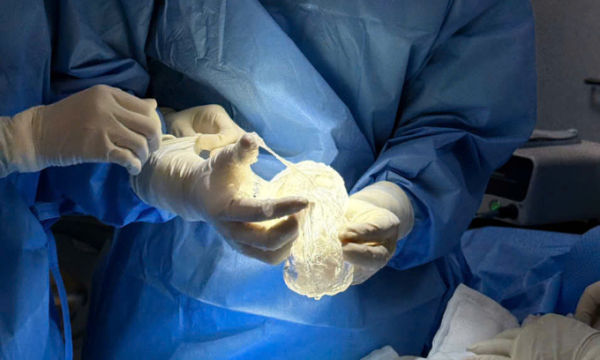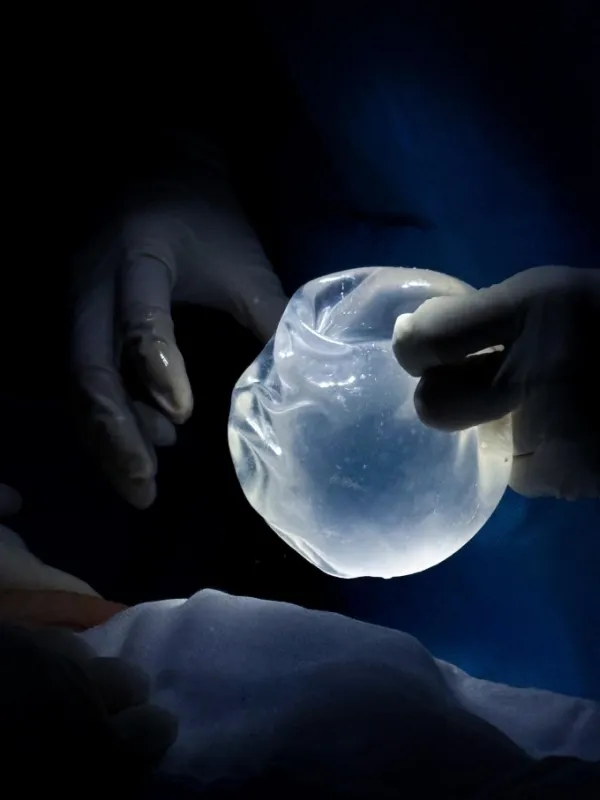
Standards for achieving soft, well-balanced breasts
During the first month after augmentation, the breasts gradually stabilize, with the implants settling symmetrically along the borders of the breast mound. The incision usually heals well, and early complications such as seroma, hematoma, or infection are rare.
Between the second and sixth month, the implants become more defined in the lower breast, and the upper-lower and medial-lateral balance improves. The breasts soften progressively each month, and nipple position and cleavage shape gradually adjust to fit each patient’s chest wall anatomy. By 6 to 12 months, the breasts typically reach optimal softness and a stable shape with minimal further change.
|
Rupture of a smooth-surfaced allergan breast implant after 8 years of augmentation. Photo courtesy of Dr. Ho Cao Vu |
Softness, elasticity, and expandability of the skin and surrounding tissue
This includes subcutaneous fat, mammary gland, Cooper’s ligaments, fascia, and pectoralis major muscle. Some patients may naturally have firmer connective tissue around the breast. Mammary gland fibrosis may be congenital or result from breastfeeding or prolonged pumping. Fibrosis in the fascial and muscular layers can also occur from intense upper-body training or dietary factors, making tissues less elastic and the implant less compatible with its surroundings.
Rarely, patients who have had prior filler injections (such as HA, liquid silicone, or autologous fat) may experience fibrosis or soft tissue damage, affecting both tissue and implant softness.
 |
|
Implant folding inside the pocket after 8 years. Photo courtesy of Dr. Ho Cao Vu |
Uniform softness and expandability of the implant pBreath
For optimal results, the implant pocket must develop uniform elasticity and expandability during healing. Surgical techniques that minimize tissue trauma and bleeding speed up recovery and result in a softer, more natural-feeling pocket that integrates well with the implant.
Matching pBreath sIze to implant volume
Surgeons must create a pocket that fits the implant size, ensuring minimal pressure during movement and muscle contraction. If the pocket is too tight, it may cause firmness due to pseudo-capsular contracture. If too loose, the implant may shift, causing asymmetry or even rotation within the pocket.
Softness of the implant
Implant softness depends on shell thickness, gel cohesiveness, and fill ratio. After selecting a certified, soft gel implant, the surgeon determines the correct diameter and projection based on the patient’s tissue elasticity, chest wall, and existing glandular tissue. Achieving a well-sized pocket and soft tissue dynamics is crucial for long-term results and depends heavily on the surgeon’s skill.
|
Explantation and implant pocket reconstruction. Photo courtesy of Dr. Ho Cao Vu |
Pseudo-capsular contracture
This can occur if the implant pocket is too tight or too wide in an imbalanced way. When the pocket is overly wide in the upper or axillary area but too tight at the intended implant position, it can lead to “pseudo-capsular contracture.” This condition, now relatively common, can often be recognized early: the breast may feel firm, lack softness, and not soften over time.
After augmentation, gradual softening, projection, and proper peak positioning are important markers. If firmness persists beyond six months, patients should be evaluated in both standing and lying positions, as early capsular contracture can be hard to spot visually. A dedicated breast MRI may be recommended to confirm diagnosis.
Key factors determining bfrom the line softness
After implant placement, the surrounding tissues need time to stretch and adapt to the implant. The goal is for the tissue’s elasticity to harmonize with the implant for a natural result. Creating an implant pocket that is neither too wide nor too tight, with minimal trauma, is essential. Ultrasonic surgical scalpels can minimize damage and promote faster softening compared to traditional techniques.
|
Surgeon performs pocket reconstruction for implant malposition after 8 years. Photo courtesy of Dr. Ho Cao Vu |
Choosing an implant brand with softness equal to or greater than the patient’s natural tissue, backed by FDA certification and over 10 years of clinical research, helps ensure long-term safety and durability.
A breast that feels unusually firm may be due to the implant being compressed in a tight pocket, which is considered normal within the first six months after surgery, especially in the first four weeks. If firmness continues past 6–12 months, it is abnormal and should be evaluated with a dedicated breast MRI.
It is also important to note that breast massage after augmentation does not promote softening and may actually increase fibrotic tissue formation, making the pocket thicker. Point dissection is preferred over blunt dissection, particularly for axillary, areolar, inframammary, or nipple base approaches.
Proficient use of advanced ultrasonic surgical scalpels, combined with point dissection techniques, offers precision in pocket creation. The surgeon’s experience in evaluating tissue softness and laxity is crucial for achieving an anatomically correct and aesthetically pleasing result, while also preventing complications such as symmastia, bottoming out, or implant migration.